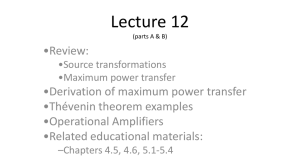Learning Objectives:
advertisement
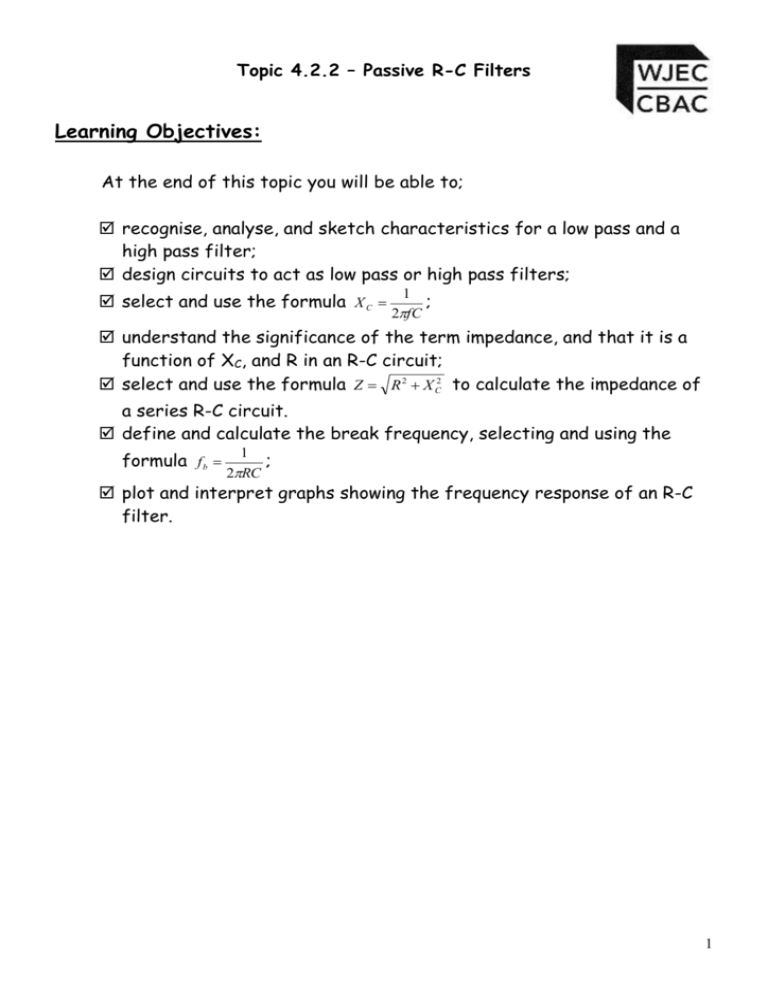
Topic 4.2.2 – Passive R-C Filters Learning Objectives: At the end of this topic you will be able to; recognise, analyse, and sketch characteristics for a low pass and a high pass filter; design circuits to act as low pass or high pass filters; select and use the formula X C 1 ; 2fC understand the significance of the term impedance, and that it is a function of XC, and R in an R-C circuit; select and use the formula Z R 2 X C2 to calculate the impedance of a series R-C circuit. define and calculate the break frequency, selecting and using the formula f b 1 ; 2RC plot and interpret graphs showing the frequency response of an R-C filter. 1 Module ET4 – Communication Systems Filters Filters fall into two main categories; 1. 2. Passive Filters Active Filters In this section we are only going to investigate passive filters, active filters will be covered in Module ET5. Passive filters can be used to suppress frequencies within a frequency spectrum. They can be made from combinations of resistors, capacitors and inductors. i) A Simple Low Pass Filter. A low pass filter (LPF) is used to remove high frequency signals from a signal spectrum. The circuit is very straightforward. The circuit consists of a resistor in series with a capacitor. The output voltage is taken across the capacitor as shown. In order to understand the way in which the circuit works we must remember that we are essentially dealing with an a.c. circuit. In an a.c. circuit capacitors behave in a different way to when they are in a d.c. circuit. We say that capacitors do not have resistance but reactance, to identify that it is in an a.c. circuit and it is given the symbol XC. It is measured in Ohms (Ω) 2 Topic 4.2.2 – Passive R-C Filters To calculate the reactance of the capacitor at any given frequency we can simply use the following equation. XC 1 2fC Where XC is the reactance (measured in ohms), f is the frequency of the a.c. signal measured in Hertz and C is the value of the capacitance in farads. Resistance is not affected by an a.c. signal and we do not have to use any different formulae to calculate resistance in an a.c. circuit. When considering the effect of the resistance and capacitor in a circuit together, we define a new term for the combined effect of resistance and reactance as impedance, given the symbol Z. To find the total impedance in the circuit, we cannot simply add the reactance of the capacitor, to that of the resistor, again another formula is required. The total impedance of the circuit is measured in Ohms (Ω). The formula required is as follows: Z R 2 X C2 Special Note: The proof of these two equations is quite complicated, involving detailed analysis of the a.c. circuit, and vector addition. These elements have been removed from the syllabus because they cause a great deal of confusion amongst students, and they will never be asked for in an examination. What is important from this syllabus point of view is that you are able to apply these rules to existing circuits, or to design circuits with specific parameters. It is not our intention to provide lots of mathematical proofs that will never be used. If you want to investigate these yourself please do so, you will find the proofs in any good electronics textbook. 3 Module ET4 – Communication Systems We will now go back then to the circuit and examine how we analyse the circuit and concentrate on this aspect rather than where the equations come from. The circuit is reproduced below for convenience. If we consider the circuit to be a potential divider, albeit with an a.c. power supply, we can write down a formula for the output voltage in a similar way to how we would for a circuit containing two resistors. i.e. VOUT VIN XC Z VIN R 2 X C2 XC This can be re-arranged to look at the ‘gain’ of the circuit. From your work in ET1 on op-amps you will remember that gain is defined as VOUT . It is a simple VIN matter to obtain a formula for this from the equation above. i.e. VOUT VIN XC R 2 X C2 Taking a look at the two extremes, i.e. very low and very high frequencies. When the frequency is low, X C2 R 2 , R2 will be so small it can be ignored compared to the size of XC2 and the gain will be near 1. i.e. no change. 4 Topic 4.2.2 – Passive R-C Filters When the frequency is high, R 2 X C2 , XC2 will be so small it can be ignored compared to the size of R2 and the gain will be given by :Gain(G) VOUT X C 1 VIN R 2fCR which will be <1 therefore high frequency signals will be suppressed. But what happens to mid range frequencies? At the mid range of frequencies the value of XC will eventually become equal to R at this point we have reached the transition between the two extremes, and it is given a special name called the break frequency. The break frequency has a special symbol fb. The formula to determine fb is obtained from equating the resistance with the reactance of the capacitor. At the break frequency, fb XC R 1 R 2f b C fb 1 2RC Substituting Xc=R in the formula for Gain we get: Gain VOUT VIN XC X X 2 C 2 C XC 2X 2 C XC 2 XC 1 2 therefore 1 VOUT VIN 0.707 VIN 2 At the break frequency then VOUT will be 0.7of VIN. Perhaps you can remember dealing with this when you looked at the bandwidth of amplifiers in ET1. 5 Module ET4 – Communication Systems Worked Example: Consider the following circuit: 1.8 k VIN VOUT 100 nF 0V i) ii) iii) iv) v) calculate the reactance of the capacitor at 10Hz, 100Hz, 1kHz, 10kHz and 100kHz. calculate the output voltage at each of these frequencies. calculate the break frequency of this circuit. calculate VOUT at the break frequency. plot a graph of output voltage against frequency on log graph paper. Solution: i) calculate the reactance of the capacitor at 10Hz, 100Hz, 1kHz, 10kHz and 100kHz. At 10 Hz: X C 1 1 159,154 2fC 2 10 100 109 At 100 Hz: X C At 1 kHz: X C 1 1 15,915 2fC 2 100 100 109 1 1 1,591 2fC 2 1000 100 109 At 10 kHz: X C 1 1 159 2fC 2 10 103 100 109 At 100 kHz: X C 6 1 1 15.9 2fC 2 100 103 100 109 Topic 4.2.2 – Passive R-C Filters ii) calculate the output voltage at each of these frequencies. At 10 Hz: VOUT XC R X 2 R X 2 XC R 2 X C2 At 10 kHz: VOUT At 100 kHz: VOUT iii) 2 C R 2 X C2 1800 2 159154 2 15915 VIN VIN XC 159154 1800 2 159152 1591 18002 15912 VIN XC R 2 X C2 VIN 159 1800 2 159 2 10 9.999V 10 9.936V 10 6.622V 10 0.879V 15.9 1800 2 15.9 2 10 0.088V calculate the break frequency of this circuit. fb iv) VIN XC At 100 Hz: VOUT At 1 kHz: VOUT 2 C 1 2RC 1 884.19 Hz 2 1800 100 10 9 calculate VOUT at the break frequency. 1 VIN 2 0.707 10 7.07V VOUT 7 Module ET4 – Communication Systems v) plot a graph of output voltage against frequency on log graph paper below. Theoretical Break Frequency. Frequency Response of Low Pass Filter 12 10 Vout (V) 8 6 4 2 0 1 10 100 1000 10000 100000 Frequency (Hz) Note that the shape of the graph is generally curved, but it is difficult to see sometimes exactly the path of the curve through the data points because there are so few. The way to improve on this is to use a computer running a program like excel to perform many calculations for us at smaller increases in frequency, and then plot the graph. If the data for the same circuit is calculated at intervals of 50 Hz all the way up to 100,000 Hz we get the following graph. 8 Topic 4.2.2 – Passive R-C Filters Frequency Response of Low Pass Filter (Calculations at 50Hz intervals) Theoretical Break Frequency 12 10 Vout (V) 8 6 4 2 0 1 10 100 1000 10000 100000 Frequency (Hz) We can now see the shape of the graph much more clearly, but the response is not exactly as we discussed in the ‘ideal’ case. This is because we are dealing with real component values and a real circuit. The reactance of the capacitor is changing all the time as frequency changes, it doesn’t suddenly switch from being high to low, and this causes the rolling over of the graph as it approaches the break frequency point. If we compare the graph to the ideal low pass filter characteristic covered in our previous section we can see that there are several key differences in reality. (i) there is a roll off in gain as the break frequency is approached, (ii) the gain decreases slowly over a range of frequencies i.e. there is not a vertical drop at the break frequency. (iii) there is a small output voltage even at high frequencies. You might think that it is not very effective given all these deviations from what is expected, however, in practice it works quite well for such a simple circuit. 9 Module ET4 – Communication Systems We can simplify the graph if we only want to represent the approximate characteristic of the filter by adding straight lines to the graph as shown by the dashed lines on the graph below: Frequency Response of Low Pass Filter (Calculations at 50Hz intervals) Theoretical Break Frequency 12 10 Vout (V) 8 6 4 2 0 1 10 100 1000 10000 100000 Frequency (Hz) It would be acceptable in the examination to use this straight line approximation, as it would be impossible to calculate all of the points needed to produce a really smooth curve to show the actual response. This does not mean that you don’t have be able to calculate the exact output at a specific frequency, this is a perfectly valid examination question, as is calculating the break frequency, it is just that you will not be expected to calculate hundreds of points to draw the graph accurately. 10 Topic 4.2.2 – Passive R-C Filters A more accurate plot can be obtained by using log-log paper, as shown below: Frequency Response of a Low Pass Filter (Log - Log Scale @ 50Hz intervals) VOUT (V) 100 10 1 1 10 100 1000 10000 100000 Frequency (Hz) Again it is possible to make a straight line approximation for this graph, but it is easier to draw the lines as the roll off falls at 45° as shown below. Break Frequency Frequency Response of a Low Pass Filter (Log - Log Scale @ 50Hz intervals) VOUT (V) 100 10 45° 1 1 10 100 1000 10000 100000 Frequency (Hz) 11 Module ET4 – Communication Systems Now here’s one for you to try. 2.7 k VIN VOUT 10 nF 0V i) ii) iii) iv) iv) calculate the reactance of the capacitor at 10Hz, 100Hz, 1kHz, 10kHz and 100kHz. calculate the output voltage at each of these frequencies. calculate the break frequency of this circuit. calculate VOUT at the break frequency. plot a graph of output voltage against frequency on log graph paper. Calculations : …………………………………………………………………………………………………………………………………………… …………………………………………………………………………………………………………………………………………… …………………………………………………………………………………………………………………………………………… …………………………………………………………………………………………………………………………………………… …………………………………………………………………………………………………………………………………………… …………………………………………………………………………………………………………………………………………… …………………………………………………………………………………………………………………………………………… …………………………………………………………………………………………………………………………………………… …………………………………………………………………………………………………………………………………………… …………………………………………………………………………………………………………………………………………… …………………………………………………………………………………………………………………………………………… …………………………………………………………………………………………………………………………………………… …………………………………………………………………………………………………………………………………………… 12 Topic 4.2.2 – Passive R-C Filters …………………………………………………………………………………………………………………………………………… …………………………………………………………………………………………………………………………………………… …………………………………………………………………………………………………………………………………………… …………………………………………………………………………………………………………………………………………… …………………………………………………………………………………………………………………………………………… …………………………………………………………………………………………………………………………………………… …………………………………………………………………………………………………………………………………………… …………………………………………………………………………………………………………………………………………… …………………………………………………………………………………………………………………………………………… …………………………………………………………………………………………………………………………………………… …………………………………………………………………………………………………………………………………………… …………………………………………………………………………………………………………………………………………… …………………………………………………………………………………………………………………………………………… …………………………………………………………………………………………………………………………………………… …………………………………………………………………………………………………………………………………………… …………………………………………………………………………………………………………………………………………… …………………………………………………………………………………………………………………………………………… …………………………………………………………………………………………………………………………………………… …………………………………………………………………………………………………………………………………………… …………………………………………………………………………………………………………………………………………… …………………………………………………………………………………………………………………………………………… …………………………………………………………………………………………………………………………………………… …………………………………………………………………………………………………………………………………………… …………………………………………………………………………………………………………………………………………… 13 Module ET4 – Communication Systems Graph paper to plot frequency response. 1 2 3 5 8 1 2 3 5 8 1 2 3 5 8 1 2 3 5 8 1 2 3 5 8 We have seen how to draw and sketch the characteristic when we are given a circuit diagram, but what if we are given the characteristic, and asked to design the circuit? In many respects this is a much easier problem to solve. Lets look at an example to see why. 14 1 Topic 4.2.2 – Passive R-C Filters Worked Example: Determine the value of resistor and capacitor required for a low pass filter to produce the following characteristic. VOUT 2000 frequency (Hz) In this case we are given the break frequency, at 2 kHz from the graph. Using the formula for break frequency we get: 1 2RC 1 2000 2RC fb We need to know either the value of R, or C in order to solve this equation. Sometimes in an examination you are given a few to choose from, but if you are not given any you just have to choose your own value for one and then work out the corresponding value. In this case as we have not been given any, we will try using a 22nF capacitor. The formula can now be rearranged to find R as follows: 1 2RC 1 2000 2RC fb R 1 3617 2 2000 22 10 9 A resistor of 3617Ω, would give the exact breakpoint required, but is not available in the range of preferred values, a 3.3kΩ or 3.9kΩ would be suitable, especially given the fact that the characteristic produced will be a curve anyway. 15 Module ET4 – Communication Systems ii) A Simple High Pass Filter. A high pass filter (HPF) is used to remove low frequency signals from a signal spectrum. The circuit is again very straightforward, but should not be confused with the Low Pass Filter. The circuit now consists of a capacitor in series with a resistor. The output voltage is taken across the resistor as shown. Again we consider the circuit to be a potential divider, and write down the formula for output voltage as we did before; the only difference is that the output is taken across the resistor instead of the capacitor. i.e. VOUT VIN R Z VIN R 2 X C2 R This can be re-arranged to look at the ‘gain’ of the circuit. From the previous work you will remember that gain is defined as VOUT VIN VOUT . i.e. VIN R R X C2 2 Taking a look at the two extremes, i.e. very low and very high frequencies. When the frequency is high, R 2 X C2 , XC2 will be so small it can be ignored compared to the size of R2 and the gain will be near 1. i.e. no change. 16 Topic 4.2.2 – Passive R-C Filters When the frequency is low, X C2 R 2 , R2 will be so small it can be ignored compared to the size of XC2 and the gain will be given by :Gain(G ) VOUT R VIN XC R 2fCR 1 2fC which will be <1 therefore low frequency signals will be suppressed (given that the size of capacitors used in these filters are in the nF range). But what happens to mid range frequencies? As before, at the mid range of frequencies the value of R and XC will become equal at the break frequency, fb. The formula to determine fb is obtained from equating the resistance with the reactance of the capacitor. At the break frequency, fb XC R 1 R 2f b C fb 1 2RC Note : The formula is identical to that for the low pass filter. In a similar way the value of VOUT at the break frequency will be given by : VOUT 1 VIN 2 17 Module ET4 – Communication Systems Worked Example: Consider the following circuit: 47 nF VIN VOUT 3.3 k 0V i) ii) iii) iv) v) calculate the reactance of the capacitor at 10Hz, 100Hz, 1kHz, 10kHz and 100kHz. calculate the output voltage at each of these frequencies. calculate the break frequency of this circuit. calculate VOUT at the break frequency. plot a graph of output voltage against frequency on log graph paper. Solution : i) calculate the reactance of the capacitor at 10Hz, 100Hz, 1kHz, 10kHz and 100kHz. At 10 Hz: X C 1 1 338,627 2fC 2 10 47 10 9 At 100 Hz: X C At 1 kHz: X C 1 1 33,863 2fC 2 100 47 10 9 1 1 3,386 2fC 2 1000 47 10 9 At 10 kHz: X C 1 1 339 2fC 2 10 103 47 10 9 At 100 kHz: X C 18 1 1 33.9 2fC 2 100 103 47 10 9 Topic 4.2.2 – Passive R-C Filters ii) calculate the output voltage at each of these frequencies. At 10 Hz: VOUT R R X 2 R 2 X C2 R R 2 X C2 At 10 kHz: VOUT At 100 kHz: VOUT iii) R 2 X C2 3300 338627 2 3300 VIN VIN R 3300 2 3300 2 338632 3300 3300 2 3386 2 VIN R R 2 X C2 VIN 3300 3300 2 339 2 10 0.097V 10 0.969V 10 6.979V 10 9.947V 3300 3300 2 33.9 2 10 9.999V calculate the break frequency of this circuit. fb iv) VIN R At 100 Hz: VOUT At 1 kHz: VOUT 2 C 1 2RC 1 1026.14 Hz 2 3300 47 10 9 calculate VOUT at the break frequency. 1 VIN 2 0.707 10 7.07V VOUT 19 Module ET4 – Communication Systems iv) plot a graph of output voltage against frequency on log graph paper below. Frequency Response of High Pass Filter Theoretical Break 12 Frequency. 10 Vout (V) 8 6 4 2 0 1 10 100 1000 10000 100000 Frequency (Hz) Note that once again the shape of the graph is generally curved, but it is difficult to see sometimes exactly the path of the curve through the data points because there are so few. Again we can use Excel to make a better attempt at this by calculating all of the data for the same circuit is intervals of 50 Hz all the way up to 100,000 Hz we get the following graph. 20 Topic 4.2.2 – Passive R-C Filters Theoretical Break Frequency Frequency Response of a High Pass Filter 12 10 VOUT 8 6 4 2 0 1 10 100 1000 10000 100000 Frequency (Hz) We can now see the shape of the graph much more clearly. If we compare the graph to the ideal high pass filter characteristic covered in our previous section we can see that there are several key differences in reality. (i) there is a roll off in gain as the break frequency is approached, (ii) the gain decreases slowly over a range of frequencies i.e. there is not a vertical drop at the break frequency. (iii) there is a small output voltage even at low frequencies. You might think that it is not very effective given all these deviations from what is expected, however, in practice it works quite well for such a simple circuit. 21 Module ET4 – Communication Systems We can simplify the graph if we only want to represent the approximate characteristic of the filter by adding straight lines to the graph as shown by the dashed lines on the graph below: Theoretical Break Frequency Frequency Response of a High Pass Filter 12 10 VOUT 8 6 4 2 0 1 10 100 1000 10000 100000 Frequency (Hz) It would be acceptable in the examination to use this straight line approximation, as it would be impossible to calculate all of the points needed to produce a really smooth curve to show the actual response. This does not mean that you don’t have be able to calculate the exact output at a specific frequency, this is a perfectly valid examination question, as it calculating the break frequency, it is just that you will not be expected to calculate hundreds of points to draw the graph accurately. 22 Topic 4.2.2 – Passive R-C Filters Once again a more accurate an appropriate way to draw this graph would be on log – log graph paper as shown below. Frequency Response of a High Pass Filter VOUT 100 10 1 1 10 100 1000 10000 100000 Frequency (Hz) Again it is possible to make a straight line approximation for this graph, but it is easier to draw the lines as the roll off falls at 45° as shown below. Frequency Response of a High Pass Filter VOUT 100 Break Frequency 10 45° 1 1 10 100 1000 10000 100000 Frequency (Hz) 23 Module ET4 – Communication Systems Now here’s one for you to try. 22 nF VIN VOUT 1.8 k 0V i) ii) iii) iv) v) calculate the reactance of the capacitor at 10Hz, 100Hz, 1kHz, 10kHz and 100kHz. calculate the output voltage at each of these frequencies. calculate the break frequency of this circuit. calculate VOUT at the break frequency. plot a graph of output voltage against frequency on log graph paper. Calculations : …………………………………………………………………………………………………………………………………………… …………………………………………………………………………………………………………………………………………… …………………………………………………………………………………………………………………………………………… …………………………………………………………………………………………………………………………………………… …………………………………………………………………………………………………………………………………………… …………………………………………………………………………………………………………………………………………… …………………………………………………………………………………………………………………………………………… …………………………………………………………………………………………………………………………………………… …………………………………………………………………………………………………………………………………………… …………………………………………………………………………………………………………………………………………… …………………………………………………………………………………………………………………………………………… …………………………………………………………………………………………………………………………………………… …………………………………………………………………………………………………………………………………………… 24 Topic 4.2.2 – Passive R-C Filters …………………………………………………………………………………………………………………………………………… …………………………………………………………………………………………………………………………………………… …………………………………………………………………………………………………………………………………………… …………………………………………………………………………………………………………………………………………… …………………………………………………………………………………………………………………………………………… …………………………………………………………………………………………………………………………………………… …………………………………………………………………………………………………………………………………………… …………………………………………………………………………………………………………………………………………… …………………………………………………………………………………………………………………………………………… …………………………………………………………………………………………………………………………………………… …………………………………………………………………………………………………………………………………………… …………………………………………………………………………………………………………………………………………… …………………………………………………………………………………………………………………………………………… …………………………………………………………………………………………………………………………………………… …………………………………………………………………………………………………………………………………………… …………………………………………………………………………………………………………………………………………… …………………………………………………………………………………………………………………………………………… …………………………………………………………………………………………………………………………………………… …………………………………………………………………………………………………………………………………………… …………………………………………………………………………………………………………………………………………… …………………………………………………………………………………………………………………………………………… …………………………………………………………………………………………………………………………………………… …………………………………………………………………………………………………………………………………………… …………………………………………………………………………………………………………………………………………… 25 Module ET4 – Communication Systems Graph paper to plot frequency response. 1 2 3 5 8 1 2 3 5 8 1 2 3 5 8 1 2 3 5 8 1 2 3 5 8 Time now to look at a design question where the characteristic is given and component values have to be calculated. Worked Example: Design a high pass filter to produce the following characteristic, you have available the following capacitors, 10µF, 22nF, and 0.47pF to choose from. Draw the circuit diagram of the completed filter. How would you expect the actual performance of your filter to compare to the profile shown ? VOUT 26 8000 frequency (Hz) 1 Topic 4.2.2 – Passive R-C Filters In this case we are given the break frequency, at 8 kHz from the graph. Using the formula for break frequency we get: 1 2RC 1 8000 2RC fb We are also told that we have a choice of three capacitors available 10µF, 22nF and 0.47pF. How do you decide which to use ? Well this comes with experience, but if you really have no idea, try calculating the value of R with each one. Assume the E24 series of resistors is available. With C=10µF 1 2RC 1 8000 2RC fb R 1 1.98 2 2 8000 10 10 6 With C=22nF 1 2RC 1 8000 2RC fb R With C=0.47pF 1 904.28 910 2 8000 22 10 9 1 2RC 1 8000 2RC fb R 1 42328442 43M 2 8000 0.47 10 12 Having calculated the three resistors, the 2Ω resistor is unsuitable as it has too low a resistance drawing an excess current from the source and 43MΩ is beyond the E24 series which stops at 10MΩ. Therefore 910Ω would be the most acceptable resistor to use here from a practical point of view. 27 Module ET4 – Communication Systems The completed circuit will therefore look like this: 22 nF VIN VOUT 910 0V In practice the response of the circuit above will be more curved and will be more like the following: Now for some practice examination questions. 28 Topic 4.2.2 – Passive R-C Filters Examination Style Questions. 1. The following circuit is to be used as a filter. 5.1 k VIN VOUT 10 nF 0V ……………………………………………… [1] a. What is the name of this type of filter ? b. Calculate the reactance of the capacitor at 100 Hz. ……………………………………………………………………………………………………… ……………………………………………………………………………………………………… ……………………………………………………………………………………………………… [2] c. Estimate the reactance of the capacitor at 10 kHz. ……………………………………………………………………………………………………… [1] d. Calculate the break frequency for this filter. ……………………………………………………………………………………………………… ……………………………………………………………………………………………………… ……………………………………………………………………………………………………… [2] e. Sketch the characteristic of this filter labelling all critical values. VOUT Frequency (kHz) [2] 29 Module ET4 – Communication Systems 2. The following circuit is to be used as a filter. 47 nF VIN VOUT 1.5 k 0V ……………………………………………… [1] a. What is the name of this type of filter ? b. Calculate the reactance of the capacitor at 1000 Hz. ……………………………………………………………………………………………………… ……………………………………………………………………………………………………… ……………………………………………………………………………………………………… [2] c. What is the impedance of the circuit at 1000 Hz. ……………………………………………………………………………………………………… ……………………………………………………………………………………………………… ……………………………………………………………………………………………………… [2] d. Calculate the output voltage if VIN = 10V at 1000 Hz. ……………………………………………………………………………………………………… ……………………………………………………………………………………………………… ……………………………………………………………………………………………………… [1] e. Calculate the break frequency for this filter. ……………………………………………………………………………………………………… ……………………………………………………………………………………………………… ……………………………………………………………………………………………………… [2] 30 Topic 4.2.2 – Passive R-C Filters f. Sketch the characteristic of this filter labelling all critical values. VOUT Frequency (kHz) [2] 3. The ideal frequency response for a filter is shown below. VOUT 6500 a) frequency (Hz) This filter is built using a simple RC circuit. Sketch the response you are likely to obtain from the simple RC filter circuit clearly showing how it would differ from the ideal response which is shown as a dotted line. VOUT 6500 frequency (Hz) 31 Module ET4 – Communication Systems b. You have available the following capacitors, 1µF, 47nF, and 6.8pF and the E24 series of resistors to choose from. Calculate the most suitable resistor for this filter. …….……………………………………………………………………………………………… …….……………………………………………………………………………………………… …….……………………………………………………………………………………………… …….……………………………………………………………………………………………… …….……………………………………………………………………………………………… …….……………………………………………………………………………………………… …….……………………………………………………………………………………………… c. [3] Draw the circuit diagram of the completed filter, label all component values and input and output terminals. [2] d. Give reasons why you have chosen the components you have for your filter. .............................................................................................................................................................. .............................................................................................................................................................. .............................................................................................................................................................. .............................................................................................................................................................. [2] 32 Topic 4.2.2 – Passive R-C Filters 4. A low pass filter is required to correspond to the following characteristic. You can assume you have access to any standard value capacitors and resistors. VOUT 4500 a. What is the break frequency of this filter ? frequency (Hz) ……………………………… [1] b. Draw the circuit diagram of a low pass filter. [2] c. Determine the value of the components required to realise the function of the low pass filter identified in the characteristic. ……………………………………………………………………………………………………….. ……………………………………………………………………………………………………….. ……………………………………………………………………………………………………….. ……………………………………………………………………………………………………….. ……………………………………………………………………………………………………….. ……………………………………………………………………………………………………….. ……………………………………………………………………………………………………….. ……………………………………………………………………………………………………….. ……………………………………………………………………………………………………….. ……………………………………………………………………………………………………….. [4] 33 Module ET4 – Communication Systems Self Evaluation Review Learning Objectives My personal review of these objectives: recognise, analyse, and sketch characteristics for a low pass and a high pass filter; design circuits to act as low pass or high pass filters; select and use the formula XC 1 ; 2fC understand the significance of the term impedance, and that it is a function of XC, and R in an R-C circuit; select and use the formula Z R 2 X C2 to calculate the impedance of a series R-C circuit. define and calculate the break frequency, selecting and using the formula f b 1 ; 2RC plot and interpret graphs showing the frequency response of an R-C filter. Targets: 1. ……………………………………………………………………………………………………………… ……………………………………………………………………………………………………………… 2. ……………………………………………………………………………………………………………… ……………………………………………………………………………………………………………… 34


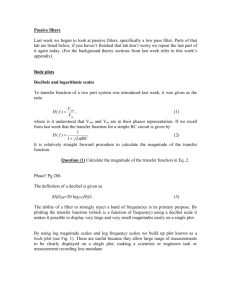

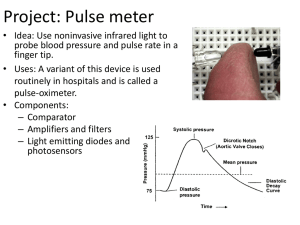
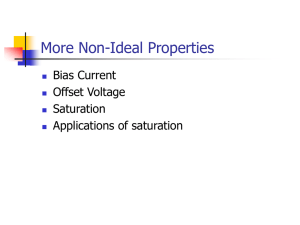
![Sample_hold[1]](http://s2.studylib.net/store/data/005360237_1-66a09447be9ffd6ace4f3f67c2fef5c7-300x300.png)

